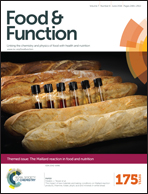Salacia chinensis L. extract ameliorates abnormal glucose metabolism and improves the bone strength and accumulation of AGEs in type 1 diabetic rats
Abstract
Although extracts of the roots and stems of Salacia chinensis have been used in folk medicines for chronic diseases such as rheumatism, irregular menstruation, asthma and diabetes mellitus, little is known about the mechanism by which Salacia chinensis extract (SCE) ameliorates these diseases. To clarify whether SCE ameliorates the progression of lifestyle-related diseases, the inhibitory effect of SCE on the formation of advanced glycation end products (AGEs) was analyzed in a rat model of streptozotocin-induced diabetes. Although the oral administration of SCE did not ameliorate the diabetes-induced decrease in body weight, it ameliorated the increase in glycoalbumin levels in diabetic rats. An analysis by liquid chromatography tandem mass spectrometry (LC-MS/MS) demonstrated that the levels of Nε-(carboxymethyl)lysine (CML) were highest in the femurs and that they increased by the induction of diabetes. The administration of SCE also ameliorated the decreased femur strength and the accumulation of CML. Furthermore, when all of the carbohydrates in the chow of diabetic rats were replaced with free glucose, the administration of SCE significantly ameliorated a diabetes-induced increase in glycoalbumin and decrease in serum creatinine level and body weight. This study provides evidence to support that SCE ameliorates diabetes-induced abnormalities by improving the uptake of glucose by various organs.

- This article is part of the themed collection: The Maillard reaction in food and nutrition

 Please wait while we load your content...
Please wait while we load your content...